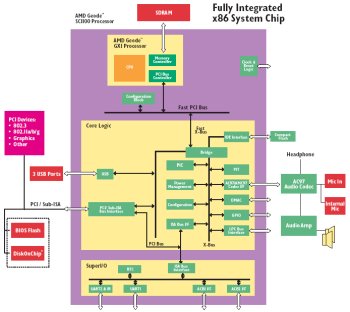New AMD reference design supports Geode SoC and Linux
Feb 15, 2005 — by LinuxDevices Staff — from the LinuxDevices Archive — views AMD has released a pair of ETX form-factor reference designs based on its low-power, Geode SC1100/SC1200 x86-based system-on-chip processors. The DBSC1100 and DBSC1200 (pictured) support Linux and are suitable for use in applications such as set-top boxes, thin clients, and information appliances, according to AMD.
AMD has released a pair of ETX form-factor reference designs based on its low-power, Geode SC1100/SC1200 x86-based system-on-chip processors. The DBSC1100 and DBSC1200 (pictured) support Linux and are suitable for use in applications such as set-top boxes, thin clients, and information appliances, according to AMD.
(Click here for larger image showing the ETX modules on a carrier board)
The boards are built in the ETX “computer-on-module” form-factor, and are intended to plug into application-specific baseboards. The DBSC1100 is based on AMD's SC1100, a system-on-chip processor, which integrates a 32-bit AMD Geode GX1 x86-compatible processor along with PC core functionality, USB, IDE, a PCI bus interface, an LPC bus interface, ACPI 1.0 compliant power management, an audio codec, serial port, infrared interface, two ACCESS.bus interfaces, and a real-time clock (see function diagram, below). The DBSC1200 incorporates the SC1200, which is similar to the SC1100 but adds video functionality for advanced set-top box applications.

Functional diagram of the AMD Geode-based SC1100 SoC
(Click image for a larger view)
AMD lists the following features and specifications for the DBSC1100 and DBSC1200 reference design boards:
- Low-power, x86-compatible processor running at 266 MHz
- Memory:
- 128 MB 144-pin SDRAM SODIMM
- 4 megabit Flash boot ROM in 32-pin PLCC socket
- Industry-standard ETX form-factor — 115mm x 95mm
- Functions included on the board-to-board interface connectors include:
- Enhanced IDE ATA 33 interface
- “Sub-ISA” bus
- PCI bus
- I/O interfaces — Ethernet, USB 1.1 (x3), PS2 ports, LPC,
- Audio — AC'97 v2.0 audio inputs and outputs
- Video — analog CRT, NTSC/PAL TV out, TFT, and CCIR-656 VIP
AMD says it supplies the boards along with schematics, documentation, and a complete software driver package. The combination of CPU module and base board is intended to be incorporated into a wide range of end-user designs without modifications, according to the company.
About ETX
The ETX module format was originated by JUMPtec, which was subsequently acquired by Kontron. The modules are generally installed on application specific baseboards much like an integrated circuit component, in a “host” site comprised of four low profile, surface mount connectors. The baseboard provides the drive electronics and physical connectors for the I/O originating on the ETX module. Additional I/O and application-specific subsystems can be integrated on the baseboard, designed as PCI or ISA bus peripherals.
Pricing and Availability
The DBSC1100 and DBSC1200 development boards are $900 each. The DBSC1200 is available now, and the DBSC1100 is excpected to be available in April.
This article was originally published on LinuxDevices.com and has been donated to the open source community by QuinStreet Inc. Please visit LinuxToday.com for up-to-date news and articles about Linux and open source.